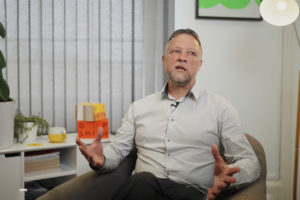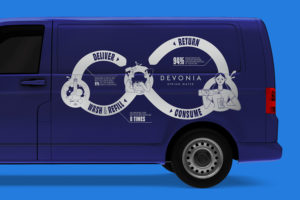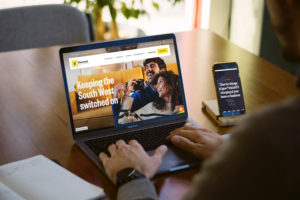
Students: How to stand out at a portfolio review
26th January 2021
Every year Plymouth University’s BA(Hons) Graphic Communication with Typography course offers their third years the chance to experience a day of portfolio reviews with professional designers in the industry.
It’s a great event, and a lovely excuse for a day out of the studio catching up with some old faces and meeting new friends. And it’s really valuable for those students too. I hope.
This year the event will go ahead but it will be an online version (thanks COVID) and might be a bit strange. So I wanted to take a few points that come up every year and put a little article together to help some of those students get a head start. It might be useful for students at other universities too, whether they are taking part in a similar activity or finding other opportunities to meet potential employers and gather feedback. So here’s a few points to get you started, and there might be a follow up article to follow next week. Just my opinion of course…
1. First things first
Relax and introduce yourself. For some of your class this might be natural, for others less so. But start by knowing that we’re here to help. We’ve been there before. We understand the nerves – many of us still get them in similar presentation scenarios ourselves, and the last thing we want to do is be mean or embarrass you. Just tell us who you are, and we’ll probably spend a couple of minutes just chatting about you, where you’re from, what you’re into – it’ll help us understand where you’re coming from and build a bit of nice early rapport.
2. Find the right tone
Do you need to come across as confident? I’ve met a fair number of students in these situations now and I know there are different kinds of ‘confident’. There are the naturally confident types. If that’s you, great – make sure you manage it so it doesn’t come across too cocky; just be yourself and we’ll get on like a house on fire.
But what if you don’t have a natural swagger? It’s hard to just ‘be confident’ sometimes but you can be positive. Start by assuming we’re interested in what you’re showing us at least. Remember you created this work and you’re in a safe place to practise talking about it – it’s a great skill to learn.
3. Show us the best you’ve got
Your tutors have probably already given you guidance about this, but 3-4 pieces with all killer and no filler is enough. The projects you choose should reflect what you’re most interested in within the world of design (if you’re into branding, show us some branding, for example), but also your ability to adapt and try new things to improve your skillset. Try to make time to review your portfolio well in advance and look for opportunities to improve or add depth to each project a little before your review/interview (see point 7 below). Critique it and see if there are opportunities to add value to it.
Make sure you can explain why each project you show is there and what you want to show us through it.
4. Be ready to answer ‘Why?’
The role of a designer is to discover and communicate great ideas and solutions. One of the key skills needed to achieve this is curiosity – the ability to ask, and answer, the question ‘WHY?’. Why are you studying design in the first place? Why did you choose this particular problem to solve? Why might your tutors have encouraged a particular direction? Why might this design take this particular form or be presented in this way? We’re likely to want to know ‘why’ quite a lot so be prepared!
5. Context
What is your project aiming to achieve? Who is the audience? (We ask this question a lot!). How do they interact with your design, and how should they respond? Any graphic design should have context so if you can show us that you understand this in at least a few of your projects we’ll be impressed.
Designing a billboard ad? Don’t just show a resized version of the brochure cover – make it a compelling advert with a call to action. Designing a piece of packaging? Show it on a shelf with other products and on its own point of sale display. Designing an app? Show what kind of content they might share on social media too.
In normal times I’d also add that if you create something 3D (packaging, books, magazines etc.) then bring them along for us to hold, but obviously that’s not possible remotely!
…find at least one practical step to follow up and actually do after each review.
6. Challenge your ideas
Think about how much further you could have taken your ideas and how much better they’d be if you’d had the time.
Here’s the kicker – you DO have the time, so make it happen!
Take point five above for example. This talks about the natural context of your design – packaging on shelf, digital product online etc. But these things don’t live in isolation in the real world. Packaging also lives on social media, on websites, in magazine ads, at exhibitions and trade shows. The context might change, the message might need to adapt – your illustrated/surface pattern-based design might need to be used alongside photography somehow to make it more appealing to real people. How might you use your skills to transition that change?
You don’t need to turn all your projects into sprawling 20 page decks, but if you can show us that your mind is inquisitive and adaptable it’ll be a major bonus.
7. Revisit old projects
Whether it’s to do the above and add new aspects, or just to tidy up/remake a first year project utilising the skills you’ve developed since that module, revisiting old work is a great idea. First year projects are often more basic in their requirements and your skills wouldn’t have been so honed. How might you approach the problem now? How can you smooth the rough edges and perhaps give it a new lease of life? Going back and making adjustments before you show us gives us a great idea of how your critical thinking and design skills have developed.
8. Show your workings
I know – it’s lovely to see a load of bright shiny ‘finished’ work that shows off your aesthetic taste and skills on trendy mockups, but what’s been going on behind the scenes?
How did you get there? How many ideas did you come up with and have to ditch because they didn’t quite work? How many sketches did it take to craft that perfect form? In studio life, we often need to really dig down into the brief and generate a lot of ideas before we find the right one – it’s helpful to know that you approach your designs in a similar way. Designers LOVE seeing how other designers think. Don’t bombard us with sketchbooks full of notes but give us an insight in at least one of your projects.
Designing a billboard ad? Don’t just show a resized version of the brochure cover – make it a compelling advert with a call to action.
9. Take the advice and apply it
There are a number of great reasons for doing a portfolio review while you’re at university. One is to facilitate a ‘practice’ session and a safe place to experience an interview-style scenario. Another is to find ways to improve your approach for when the real interviews come.
Take some notes, find at least one practical step to follow up and actually do after each review. Ask for advice if you aren’t sure what would be a good focus and hopefully your panel will be able to make a suggestion.
10. Follow up!
If you feel like you click with the people on your panel, keep in touch with them. Follow them on Instagram and connect on Linkedin. Ask if you can email them afterwards for further questions. Depending on a few factors they might be really happy to see you again in a month or two so you can show them how you put their advice into practice. And who knows, when you graduate there might be internships, work experience or even jobs that come up with those guys, and you know who’s going to be front and centre in their mind.
—
That’s a few things to get you started. Any of this feel helpful? Any other questions you’d like to ask? Let us know, and keep your eyes peeled for more on this in the coming weeks.





